technical data FIAT DOBLO COMBI 2014 Owner handbook (in English)
[x] Cancel search | Manufacturer: FIAT, Model Year: 2014, Model line: DOBLO COMBI, Model: FIAT DOBLO COMBI 2014Pages: 283, PDF Size: 6.31 MB
Page 24 of 283
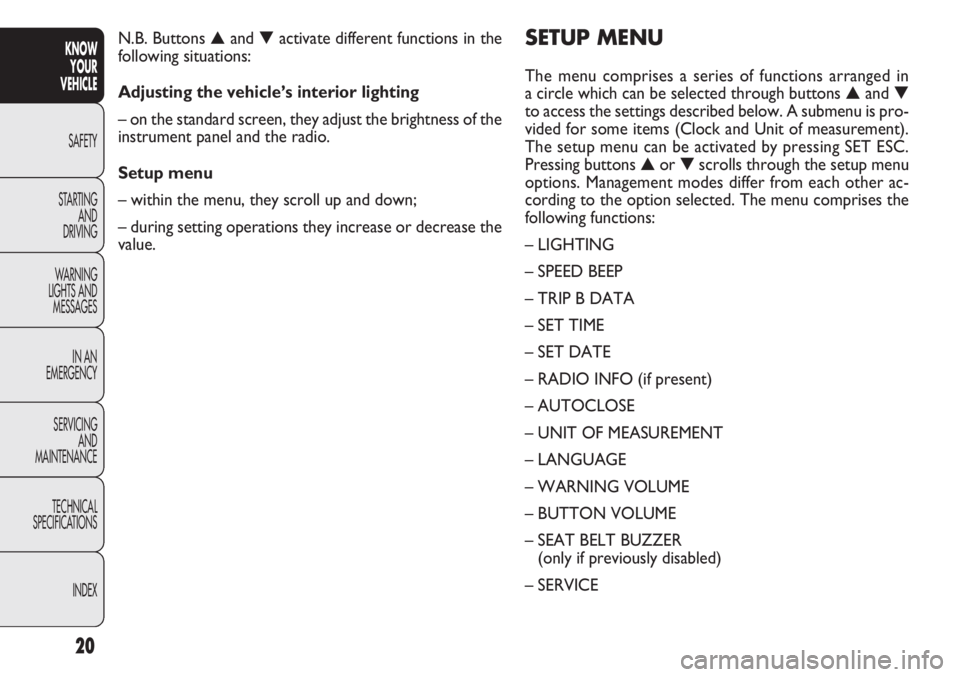
20
KNOWYOUR
VEHICLE
SAFETY
ST AR
TINGAND
DRIVING
WARNING
LIGHTS AND MESSAGES
IN AN
EMERGENCY
SERVICING AND
MAINTENANCE
TECHNICAL
SPECIFICATIONS
INDEX
SETUP MENU
The menu comprises a series of functions arranged in
a circle which can be selected through buttons ▲and ▼
to access the settings described below. A submenu is pro-
vided for some items (Clock and Unit of measurement).
The setup menu can be activated by pressing SET ESC.
Pressing buttons ▲or ▼scrolls through the setup menu
options. Management modes differ from each other ac-
cording to the option selected. The menu comprises the
following functions:
– LIGHTING
– SPEED BEEP
– TRIP B DATA
– SET TIME
– SET DATE
– RADIO INFO (if present)
– AUTOCLOSE
– UNIT OF MEASUREMENT
– LANGUAGE
– WARNING VOLUME
– BUTTON VOLUME
– SEAT BELT BUZZER (only if previously disabled)
– SERVICE
N.B. Buttons
▲and ▼activate different functions in the
following situations:
Adjusting the vehicle’s interior lighting
– on the standard screen, they adjust the brightness of the
instrument panel and the radio.
Setup menu
– within the menu, they scroll up and down;
– during setting operations they increase or decrease the
value.
Page 26 of 283

22
KNOWYOUR
VEHICLE
SAFETY
ST AR
TINGAND
DRIVING
WARNING
LIGHTS AND MESSAGES
IN AN
EMERGENCY
SERVICING AND
MAINTENANCE
TECHNICAL
SPECIFICATIONS
INDEX
–press▲or▼to select;
– press the SET ESC button to go back to the menu screen
or hold the button down to go back to the standard screen
without saving.
Setting the time (Clock)
This function allows you to set the clock through two sub-
menus: “Time” and “Mode”.
To carry out the adjustment, proceed as follows:
– press SET ESC: the display shows the two submenus
“Time” and “Mode”;
–press▲ or▼to move between the two submenus;
– once you have selected a submenu, press SET ESC;
– if the function is on, press
▲or ▼to select the required
speed limit and then press SET ESC to confirm;
N.B. The speed may be set anywhere between 30 and
200 km/h or 20 and 125 mph, depending on the previously
chosen unit (see “Setting the unit of measurement (Unit)”).
The setting will increase/decrease by five units each time
button ▲/▼ is pressed. Hold down button ▲/▼ to in-
crease/decrease the setting rapidly. Complete the setting
with single presses of the button when you approach the
required setting.
– press the SET ESC button to go back to the menu screen
or hold the button down to go back to the standard screen
without saving.
To cancel the setting, proceed as follows:
– press the SET ESC button: ON flashes in the display;
– press button ▼: OFF flashes in the display;
– press the SET ESC button to go back to the menu screen
or hold the button down to go back to the standard screen
without saving.
Trip B data (Activating Trip B)
This function may be used to activate (On) or deactivate
(Off) the Trip B display (partial trip).
For more information see the „Trip computer” section.
For activation/deactivation, proceed as follows:
– press the SET ESC button again: the display flashes On
or Off depending on what was previously set;
Page 118 of 283
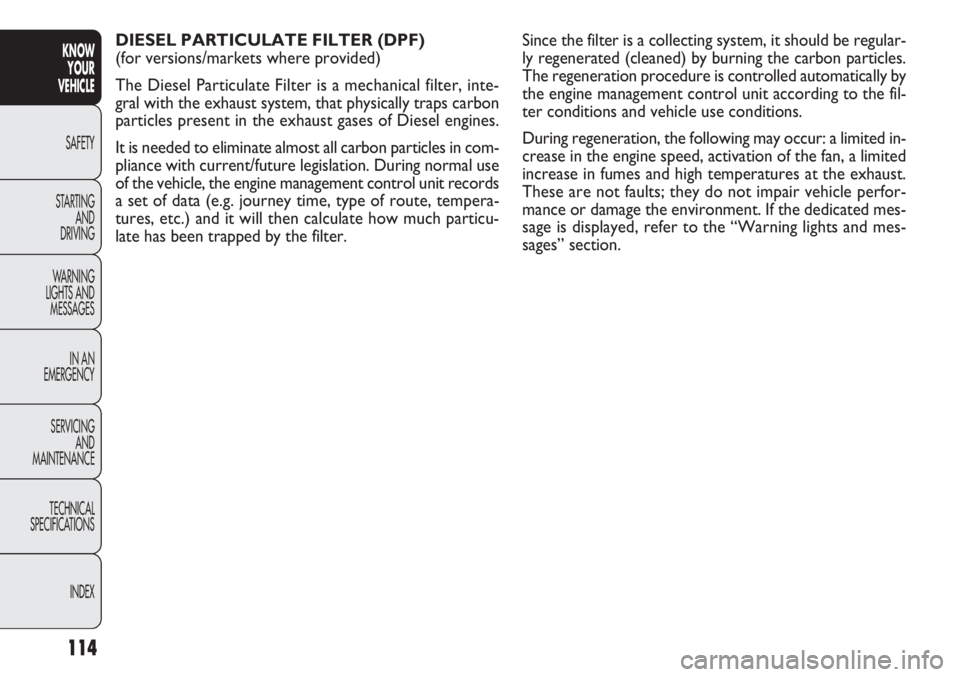
114
KNOWYOUR
VEHICLE
SAFETY
ST AR
TING AND
DRIVING
WARNING
LIGHTS AND MESSAGES
IN AN
EMERGENCY
SERVICING AND
MAINTENANCE
TECHNICAL
SPECIFICATIONS
INDEX
DIESEL PARTICULATE FILTER (DPF)
(for versions/markets where provided)
The Diesel Particulate Filter is a mechanical filter, inte-
gral with the exhaust system, that physically traps carbon
particles present in the exhaust gases of Diesel engines.
It is needed to eliminate almost all carbon particles in com-
pliance with current/future legislation. During normal use
of the vehicle, the engine management control unit records
a set of data (e.g. journey time, type of route, tempera-
tures, etc.) and it will then calculate how much particu-
late has been trapped by the filter. Since the filter is a collecting system, it should be regular-
ly regenerated (cleaned) by burning the carbon particles.
The regeneration procedure is controlled automatically by
the engine management control unit according to the fil-
ter conditions and vehicle use conditions.
During regeneration, the following may occur: a limited in-
crease in the engine speed, activation of the fan, a limited
increase in fumes and high temperatures at the exhaust.
These are not faults; they do not impair vehicle perfor-
mance or damage the environment. If the dedicated mes-
sage is displayed, refer to the “Warning lights and mes-
sages” section.
Page 124 of 283
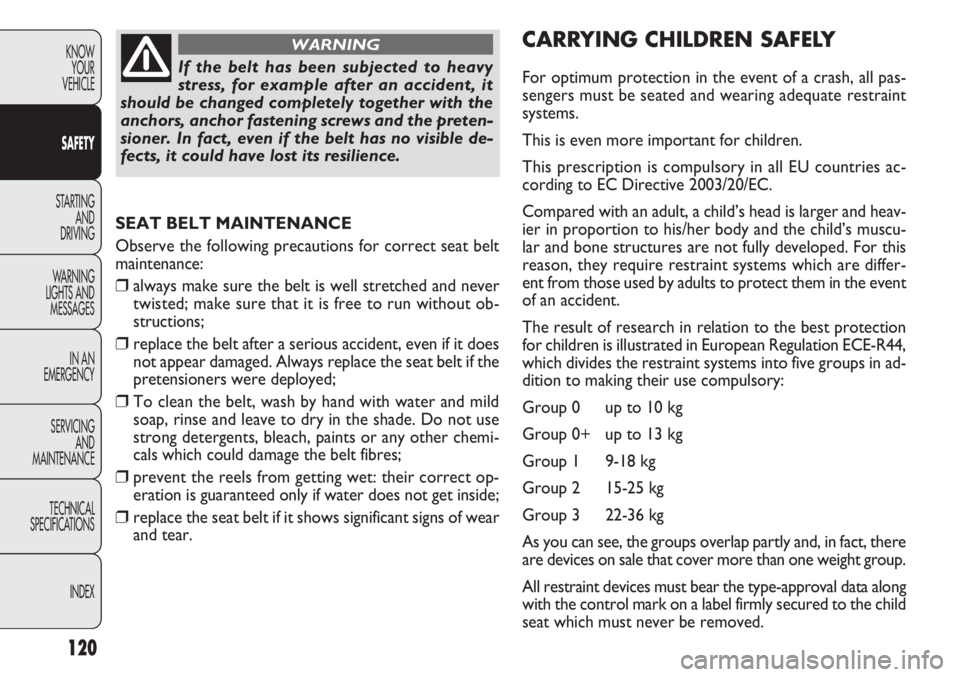
120
KNOWYOUR
VEHICLE
SAFETY
STARTING AND
DRIVING
W ARNING
LIGHTS AND MESSAGES
IN AN
EMERGENCY
SERVICING AND
MAINTENANCE
TECHNICAL
SPECIFICA
TIONSINDEX
SEAT BELT MAINTENANCE
Observe the following precautions for correct seat belt
maintenance:
❒always make sure the belt is well stretched and never
twisted; make sure that it is free to run without ob-
structions;
❒replace the belt after a serious accident, even if it does
not appear damaged. Always replace the seat belt if the
pretensioners were deployed;
❒To clean the belt, wash by hand with water and mild
soap, rinse and leave to dry in the shade. Do not use
strong detergents, bleach, paints or any other chemi-
cals which could damage the belt fibres;
❒prevent the reels from getting wet: their correct op-
eration is guaranteed only if water does not get inside;
❒replace the seat belt if it shows significant signs of wear
and tear.
If the belt has been subjected to heavy
stress, for example after an accident, it
should be changed completely together with the
anchors, anchor fastening screws and the preten-
sioner. In fact, even if the belt has no visible de-
fects, it could have lost its resilience.
WARNINGCARRYING CHILDREN SAFELY
For optimum protection in the event of a crash, all pas-
sengers must be seated and wearing adequate restraint
systems.
This is even more important for children.
This prescription is compulsory in all EU countries ac-
cording to EC Directive 2003/20/EC.
Compared with an adult, a child’s head is larger and heav-
ier in proportion to his/her body and the child’s muscu-
lar and bone structures are not fully developed. For this
reason, they require restraint systems which are differ-
ent from those used by adults to protect them in the event
of an accident.
The result of research in relation to the best protection
for children is illustrated in European Regulation ECE-R44,
which divides the restraint systems into five groups in ad-
dition to making their use compulsory:
Group 0 up to 10 kg
Group 0+ up to 13 kg
Group 1 9-18 kg
Group 2 15-25 kg
Group 3 22-36 kg
As you can see, the groups overlap partly and, in fact, there
are devices on sale that cover more than one weight group.
All restraint devices must bear the type-approval data along
with the control mark on a label firmly secured to the child
seat which must never be removed.
Page 223 of 283
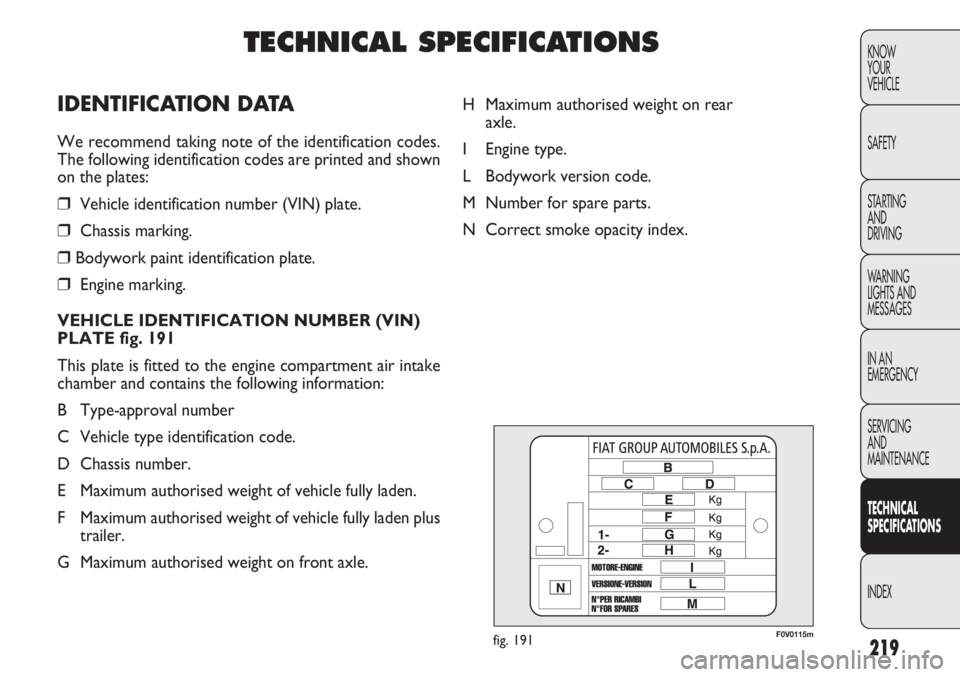
219
KNOW
YOUR
VEHICLE
SAFETY
STARTING
AND
DRIVING
WARNING
LIGHTS AND
MESSAGES
IN AN
EMERGENCY
SERVICING
AND
MAINTENANCE
TECHNICAL
SPECIFICATIO
NS
INDEX
F0V0115mfig. 191
H Maximum authorised weight on rear axle.
I Engine type.
L Bodywork version code.
M Number for spare parts.
N Correct smoke opacity index.
TECHNICAL SPECIFICATIONS
IDENTIFICAT I ON DATA
We recommend taking note of the identification codes.
The following identification codes are printed and shown
on the plates:
❒Vehicle identification number (VIN) plate.
❒Chassis marking.
❒Bodywork paint identification plate.
❒Engine marking.
VEHICLE IDENTIFICATION NUMBER (VIN)
PLATE fig. 191
This plate is fitted to the engine compartment air intake
chamber and contains the following information:
B Type-approval number
C Vehicle type identification code.
D Chassis number.
E Maximum authorised weight of vehicle fully laden.
F Maximum authorised weight of vehicle fully laden plus trailer.
G Maximum authorised weight on front axle.
Page 272 of 283
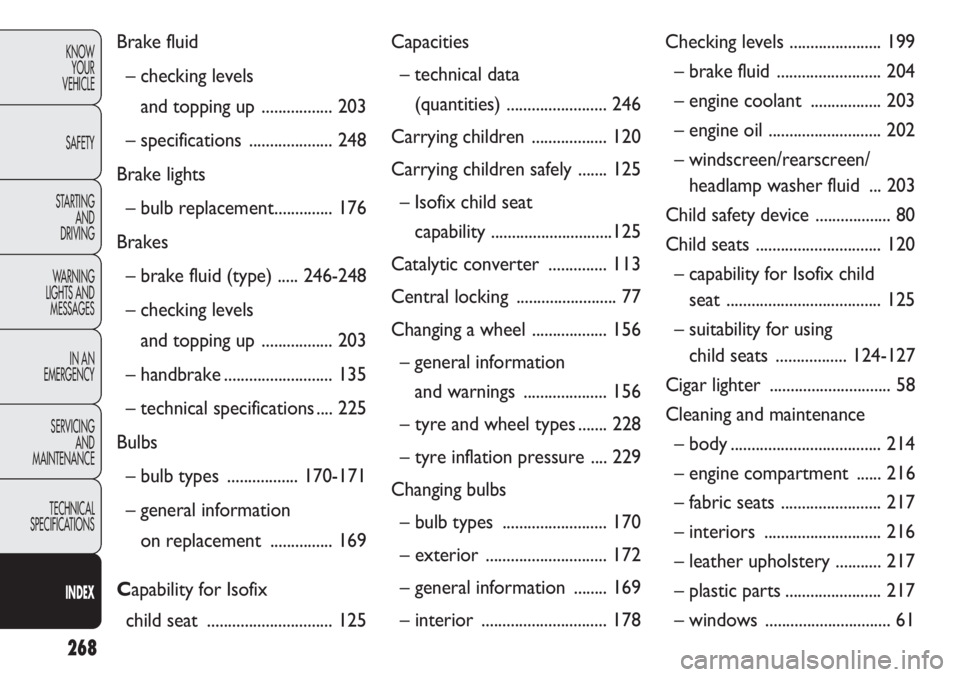
268
KNOWYOUR
VEHICLE
SAFETY
STARTING AND
DRIVING
WARNING
LIGHTS AND MESSAGES
IN AN
EMERGENCY
SERVICING AND
MAINTENANCE
TECHNICAL
SPECIFICATIONS
INDEXBrake fluid– checking levels and topping up ................. 203
– specifications .................... 248
Brake lights – bulb replace ment.............. 176
Brakes – brake fluid (type) ..... 246-248
– checking levels and topping up ................. 203
– handbrake .......................... 135
– technical specifications .... 225
Bulbs – bulb types ................. 170-171
– general information on replace ment ............... 169
C apability for Isofix
child seat .............................. 125 Capacities
– technical data (quantities) ........................ 246
Carrying children .................. 120
Carrying children safely ....... 125 – Isofix child seat capability .............................125
Catalytic converter .............. 113
Central lo cking ........................ 77
Changing a wheel .................. 156
– general information and warnings .................... 156
– tyre and wheel types ....... 228
– tyre inflation pressure .... 229
Changing bulbs – bulb types ......................... 170
– exterior ............................. 172
– general information ........ 169
– interio r .............................. 178 Checking le
vels ...................... 199
– brake fluid ......................... 204
– engine c oolant ................. 203
– engine oil ........................... 202
– windscreen/rearscreen/ headlamp washer fluid ... 203
Child safety device .................. 80
Child seats .............................. 120
– capability for Isofix child seat ..................................... 125
– suitability for using child seats .................124-127
Cigar ligh ter ............................. 58
Cleaning and maintenance – body .................................... 214
– engine compartment ...... 216
– fabric seats ........................ 217
– interio rs ............................ 216
– leather upho lstery ........... 217
– plastic parts ....................... 217
– windows .............................. 61
Page 274 of 283
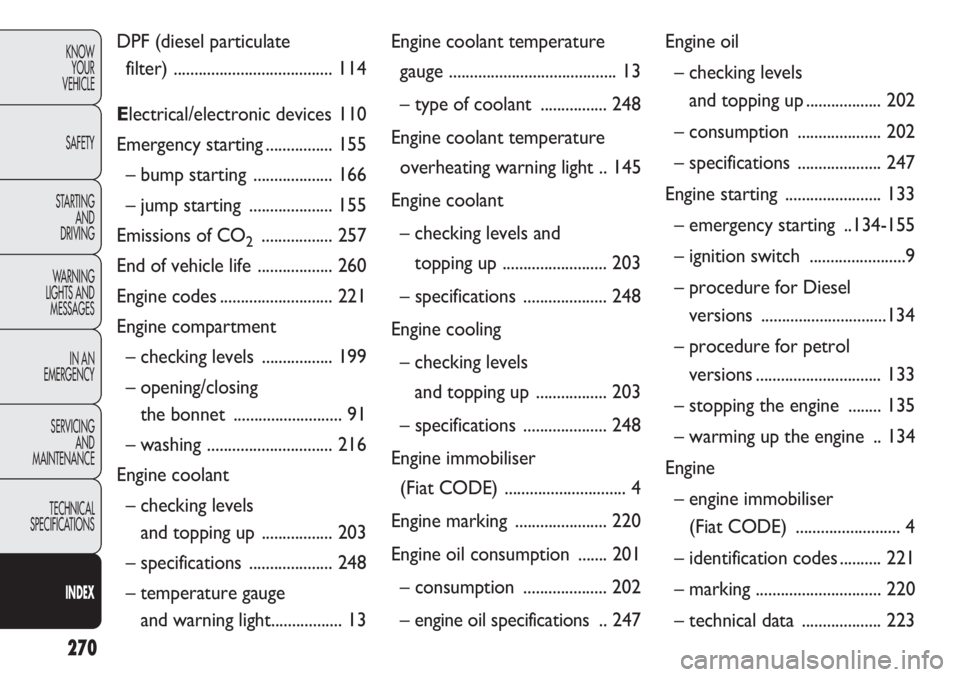
270
KNOWYOUR
VEHICLE
SAFETY
STARTING AND
DRIVING
WARNING
LIGHTS AND MESSAGES
IN AN
EMERGENCY
SERVICING AND
MAINTENANCE
TECHNICAL
SPECIFICATIONS
INDEXDPF (diesel particulate filter) ...................................... 114
E lectrical/electronic devices 110
Emergency starting ................ 155
– bump starting ................... 166
– jump starting .................... 155
Emissions of CO
2................. 257
End of vehicle life .................. 260
Engine codes ........................... 221
Engine compartment – checking le vels ................. 199
– opening/closing the bonnet .......................... 91
– washing .............................. 216
Engine coolant – checking levels and topping up ................. 203
– specifications .................... 248
– temperature gauge and warning light ................. 13Engine coolant temperature
gauge ........................................ 13
– type of coolant ................ 248
Engine coolant temperature overheating warning light .. 145
Engine coolant – checking levels and topping up ......................... 203
– specifications .................... 248
Engine cooling – checking levels and topping up ................. 203
– specifications .................... 248
Engine immobiliser (Fiat CODE) ............................. 4
Engine mark ing ...................... 220
Engine oil consumption ....... 201 – consumption .................... 202
– engine oil specifications .. 247 Engine oil
– checking levels and topping up .................. 202
– consumption .................... 202
– specifications .................... 247
Engine starting ....................... 133
– emergency starting ..134-155
– ignition switch .......................9
– procedure for Diesel versio ns ..............................134
– procedure for petrol versio ns .............................. 133
– stopping the engine ........ 135
– warming up the engine .. 134
Engine
– engine immobiliser (Fiat CODE) ......................... 4
– identification c odes .......... 221
– marking .............................. 220
– technical data ................... 223
Page 276 of 283
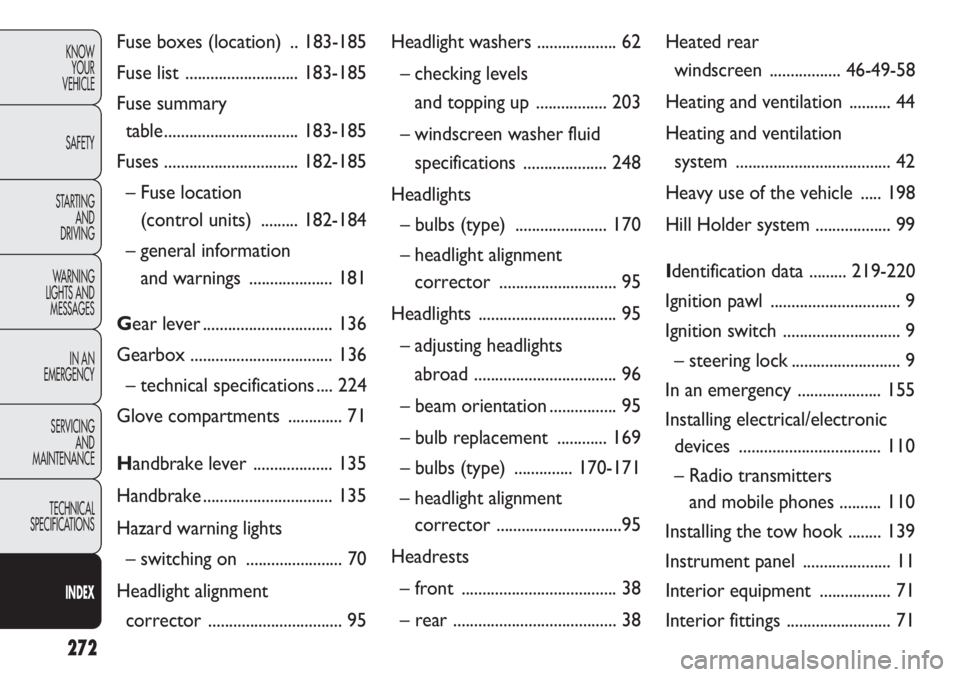
272
KNOWYOUR
VEHICLE
SAFETY
STARTING AND
DRIVING
WARNING
LIGHTS AND MESSAGES
IN AN
EMERGENCY
SERVICING AND
MAINTENANCE
TECHNICAL
SPECIFICATIONS
INDEXFuse boxes (location) .. 183-185
Fuse list ........................... 183-185
Fuse summary table ................................ 183-185
Fuses ................................ 182-185
– Fuse location (control units) ......... 182-184
– general information and warnings .................... 181
G ear leve r ............................... 136
Gearbox .................................. 136 – technical specifications .... 224
Glove compart ments ............. 71
H andbrake lever ................... 135
Handbrake ............................... 135
Hazard warning lights – switching on ....................... 70
Headlight alignment corrector ................................ 95 Headlight washers
................... 62
– checking levels and topping up ................. 203
– windscreen washer fluid specifications .................... 248
Headlights – bulbs (t ype) ...................... 170
– headlight alignment corrector ............................ 95
Headlights ................................. 95
– adjusting headlights abroad .................................. 96
– beam orie ntation................ 95
– bulb replace ment ............ 169
– bulbs (t ype) .............. 170-171
– headlight alignment corrector ..............................95
Headrests – front ..................................... 38
– rear ....................................... 38 Heated rear
windscreen .................46-49-58
Heating and vent ilation ..........44
Heating and ventilation system ..................................... 42
Heavy use of the vehicle ..... 198
Hill Holder system .................. 99
I dentification data ......... 219-220
Ignition pawl ............................... 9
Ignition switch ............................ 9
– steering lock .......................... 9
In an emer gency .................... 155
Installing electrical/electronic devices .................................. 110
– Radio transmitters and mobile phones .......... 110
Installing the tow hook ........ 139
Instrument panel .....................
11
Interior equipment .................
71
Interior fittings ......................... 71
Page 278 of 283
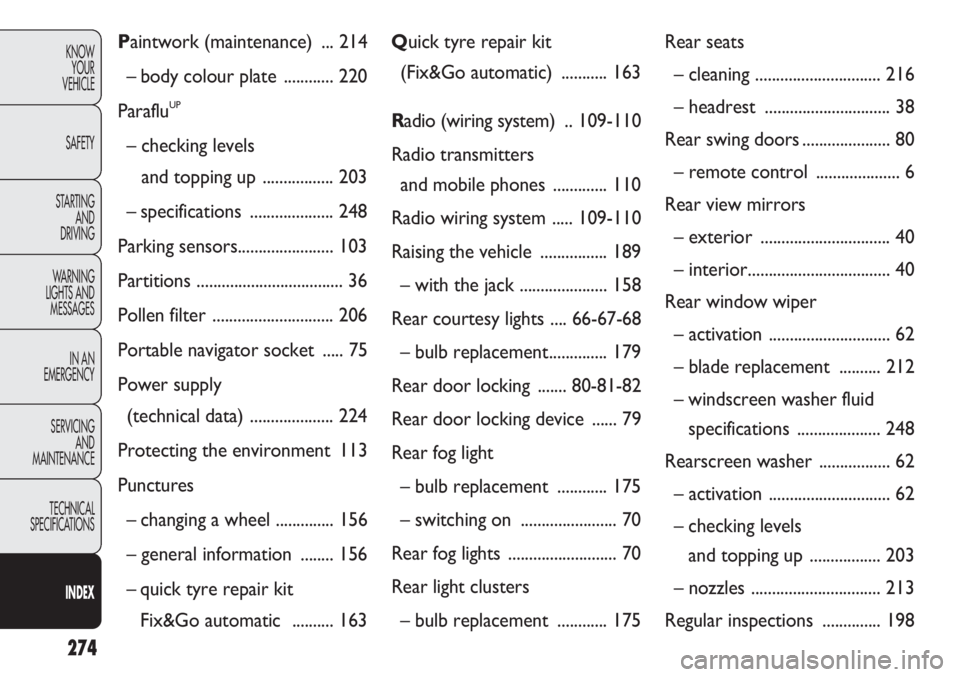
274
KNOWYOUR
VEHICLE
SAFETY
STARTING AND
DRIVING
WARNING
LIGHTS AND MESSAGES
IN AN
EMERGENCY
SERVICING AND
MAINTENANCE
TECHNICAL
SPECIFICATIONS
INDEXPaintwork (maintenance) ... 214
– body colour plate ............ 220
Paraflu
UP
– checking levels and topping up ................. 203
– specifications .................... 248
Parking sensors....................... 103
Partitions ................................... 36
Pollen filter ............................. 206
Portable navigator socket ..... 75
Power supply (technical data) .................... 224
Protecting the environment 113
Punctures – changing a wheel .............. 156
– general information ........ 156
– quick tyre repair kit Fix&Go automatic .......... 163 Q
uick tyre repair kit
(Fix&Go automatic) ........... 163
R adio (wiring system) .. 109-110
Radio transmitters and mobile phones ............. 110
Radio wiring system ..... 109-110
Raising the vehicle ................ 189
– with the jack ..................... 158
Rear courtesy lights .... 66-67-68 – bulb replace ment.............. 179
Rear door locking ....... 80-81-82
Rear door locking device ...... 79
Rear fog light – bulb replace ment ............ 175
– switching on ....................... 70
Rear fog lig hts .......................... 70
Rear light clusters – bulb replace ment ............ 175 Rear seats
– cleaning .............................. 216
– headrest .............................. 38
Rear swing doors ..................... 80
– remote control .................... 6
Rear view mirrors – exterior ............................... 40
– interio r.................................. 40
Rear window wiper – activation ............................. 62
– blade replacement .......... 212
– windscreen washer fluid specifications .................... 248
Rearscreen washer ................. 62
– activation ............................. 62
– checking levels and topping up ................. 203
– nozzles ............................... 213
Regular inspections .............. 198
Page 280 of 283
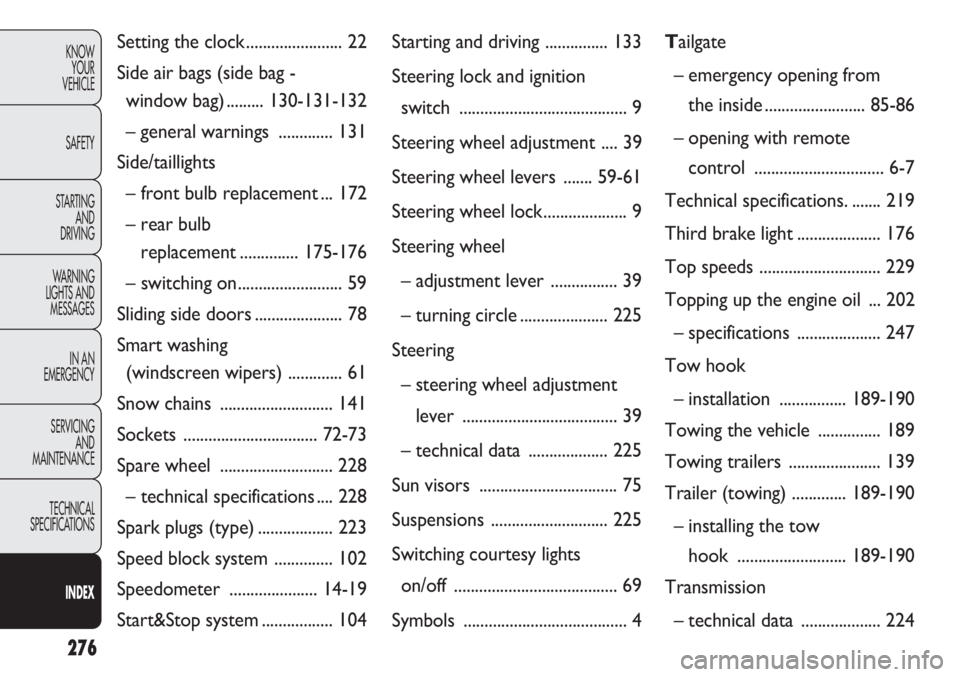
276
KNOWYOUR
VEHICLE
SAFETY
STARTING AND
DRIVING
WARNING
LIGHTS AND MESSAGES
IN AN
EMERGENCY
SERVICING AND
MAINTENANCE
TECHNICAL
SPECIFICATIONS
INDEXSetting the clock ....................... 22
Side air bags (side bag - window bag) ......... 130-131-132
– general warnings ............. 131
Side/taillights – front bulb replacement ... 172
– rear bulb replacement ..............175-176
– switching on......................... 59
Sliding side doors ..................... 78
Smart washing (windscreen wipers) ............. 61
Snow cha ins ........................... 141
Sockets ................................ 72-73
Spare wheel ........................... 228 – technical specifications .... 228
Spark plugs (type) .................. 223
Speed block system .............. 102
Speedometer .....................14-19
Start&Stop system ................. 104Starting and driving
............... 133
Steering lock and ignition switch ........................................ 9
Steering wheel adjustment .... 39
Steering wheel levers ....... 59-61
Steering wheel lock.................... 9
Steering wheel – adjustment lever ................ 39
– turning circle ..................... 225
Steering – steering wheel adjustment lever ..................................... 39
– technical data ................... 225
Sun visors ................................. 75
Suspensions ............................ 225
Switching courtesy lights on/off ....................................... 69
Symbols ....................................... 4 T
ailgate
– emergency opening from the inside ........................ 85-86
– opening with remote control ............................... 6-7
Technical specifications. ....... 219
Third brake light .................... 176
Top speeds ............................. 229
Topping up the engine oil ... 202 – specifications .................... 247
Tow hook
– installation ................189-190
Towing the vehicle ............... 189
Towing trailers ...................... 139
Trailer (towing) .............189-190
– installing the tow hook .......................... 189-190
Transmission
– technical data ................... 224